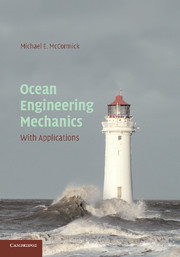Book contents
- Frontmatter
- Contents
- Preface
- Notation
- OCEAN ENGINEERING MECHANICS
- 1 Introduction
- 2 Review of Hydromechanics
- 3 Linear Surface Waves
- 4 Nonlinear Surface Waves
- 5 Random Seas
- 6 Wave Modification and Transformation
- 7 Waves in the Coastal Zone
- 8 Coastal Engineering Considerations
- 9 Wave-Induced Forces and Moments on Fixed Bodies
- 10 Introduction to Wave-Structure Interaction
- 11 Wave-Induced Motions of Floating Bodies
- 12 Wave-Induced Motions of Compliant Structures
- Appendices
- References
- Index
11 - Wave-Induced Motions of Floating Bodies
Published online by Cambridge University Press: 05 June 2012
- Frontmatter
- Contents
- Preface
- Notation
- OCEAN ENGINEERING MECHANICS
- 1 Introduction
- 2 Review of Hydromechanics
- 3 Linear Surface Waves
- 4 Nonlinear Surface Waves
- 5 Random Seas
- 6 Wave Modification and Transformation
- 7 Waves in the Coastal Zone
- 8 Coastal Engineering Considerations
- 9 Wave-Induced Forces and Moments on Fixed Bodies
- 10 Introduction to Wave-Structure Interaction
- 11 Wave-Induced Motions of Floating Bodies
- 12 Wave-Induced Motions of Compliant Structures
- Appendices
- References
- Index
Summary
Equipped with the basic analytical methods presented in Chapters 9 and 10, the wave-induced motions of floating bodies are discussed in this chapter. In Chapter 12, the final chapter of this book, those methods are applied to the wave-structure interactions of fixed structures. In this book, fixed structures are those that are either resting on the sea bed or directly supported by foundations in the bed. Floating bodies include ships, floating platforms, buoys, and other specialized bodies that are either under way or maintained in position by moorings. The motion of ships in waves is a topic in the field of naval architecture referred to as seakeeping. Thorough coverages of seakeeping are found in the writings of Korvin-Kroukovsky (1961), Newman (1977), Bhattacharyya (1978), Lloyd (1989), and Faltinsen (1990, 2005) among others. Floating bodies discussed in this chapter that are not normally under way are referred to herein as ocean engineering bodies, as opposed to ships. The geometry of an ocean engineering body normally has two vertical planes of symmetry, whereas ships have one, called the centerplane.
In this chapter, the degrees of freedom (surge, sway, heave, roll, pitch, and yaw) of a floating body are introduced and the coupled heaving and pitching motions are analyzed. The stability of a body in calm water is first discussed. Methods of motion analysis are then introduced that lend themselves to both analytical and simple numerical solutions. Body motions in waves are analyzed using the linear strip theory.
- Type
- Chapter
- Information
- Ocean Engineering MechanicsWith Applications, pp. 376 - 452Publisher: Cambridge University PressPrint publication year: 2009



